1979 Belgian Grand Prix race report
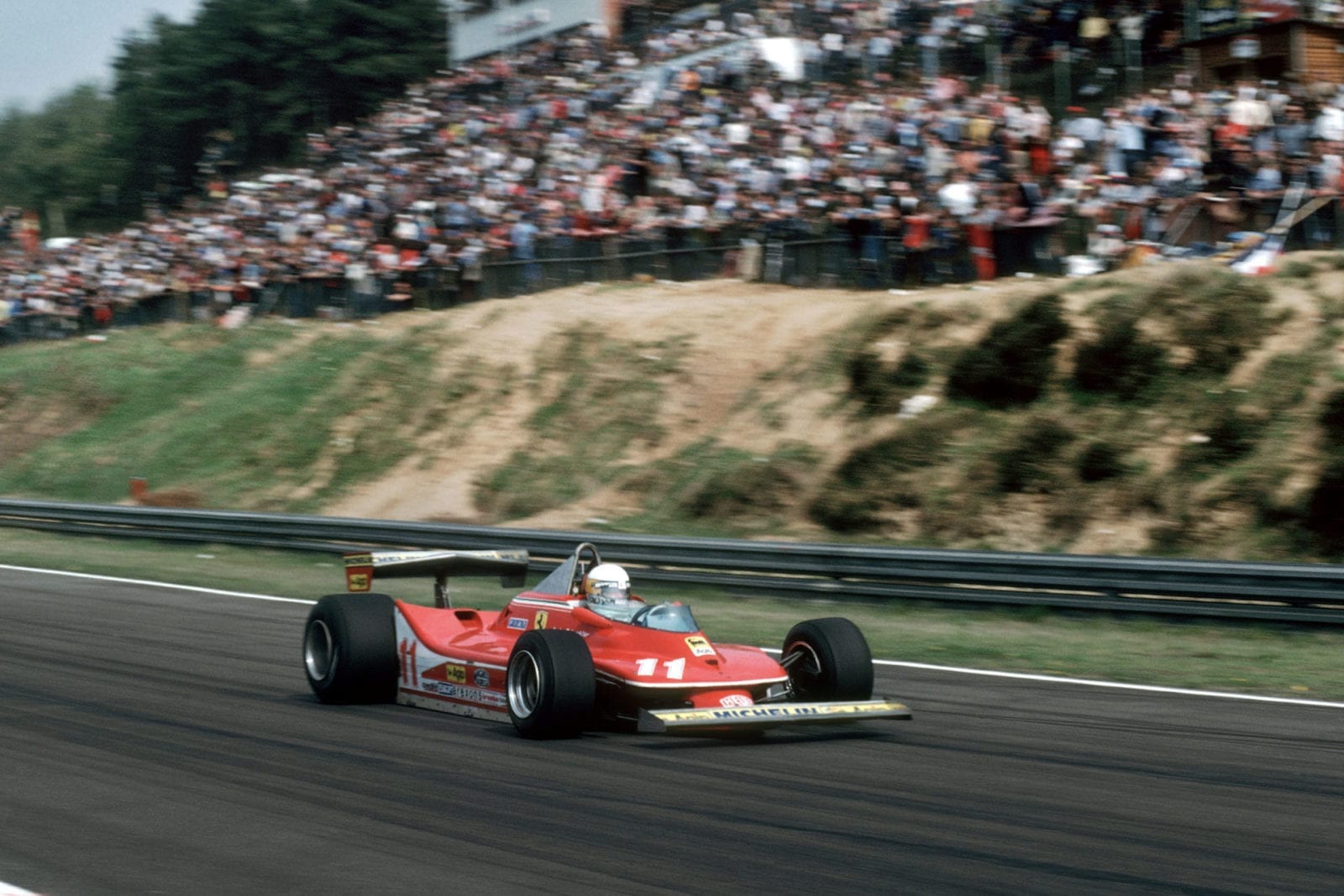
It was a first win of the season for Ferrari's Jody Scheckter
Motorsport Images
Some good driving
Zolder, May 13th
The little Zolder circuit, which is situated in the sandy scrublands of north east Belgium, not far from the Dutch border, is not the most attractive place even when the sun is shining. In the drizzling rain on Friday morning when testing and practice was due to start for the Belgian GP it was bleak. One point in favour of the Zolder track is that it does not have the air of an autodrome or racing stadium; as artificial and permanent circuits go it is quite good, like a very miniature Nurburgring. Just as our own OuIton Park is an artificial road-racing circuit, compared to Silverstone which is an airfield circuit, and Brands Hatch which is a stadium, Zolder can rate as a road-racing circuit.
Qualifying
There was not a great deal of enthusiasm for the hour-long test session on Friday morning in the drizzling rain and the Wolf and McLaren teams did not venture out, the former due to a possible shortage of wet-weather tyres and the latter because they were still finishing off their cars. The previous week both Goodyear and Michelin had held tyre-testing sessions at the circuit, during which Depailler, fresh from his Spanish GP victory, had had a slight accident in the Ligier and John Watson had had a major accident in the McLaren M28/1B and demolished it. The Colnbrook team salvaged what parts they could and built them on to the monocoque of M28/2, so that when it arrived at Zolder and was completed it became M28/2B. The third of the M28 cars was undergoing the same treatment at the factory so Tambay was having to make use of M26/7 “dragged out from under the bench.”
Team Lotus were out in force, with Andretti’s Lotus 80/1 improved in many details, with shorter nose cowling without the “skirts” under it, and new body panels along its length. A Mk. II Lotus 80 is on its way, with the centre of gravity moved forwards and with shorter side pods. Reutemann was still using a Lotus 79 and quietly getting on with the job, while both drivers had a spare Lotus 79 standing by. After making it clear to Jody Scheckter that he was supposed to be number one in the Ferrari team, and as such he should be winning races, the team provided him with a brand new car for Zolder, number 312T4/040, while his small sparrow-like team-mate took over 039, which Scheckter had raced in Spain. The blue Tyrrells of Pironi and Jarier had the word Candy painted on them, to do with a big bag of gold put into the Tyrrell coffers. The Ecclestone team had a brand new BT48, number 04, for Lauda, not fundamentally different from the others, and Lauda’s usual car BT48/2 became the team spare, Nelson Piquet keeping to BT48/3. Renault had fitted double-caliper brakes to the front of their new car, RS10/01, which Jabouille was driving again, while Arnoux retained his usual earlier car. Some of the lesser teams were in trouble before the meeting began, Team Ensign had done a major revamp on MN09 but were held up for fibreglass work for new bodywork. so bundled their two old cars, MN06 and MN08, into the transporter and set off. Fittipaldi sent their Copersucar sponsored F6 back for a complete re-appraisal and EF was using his “old faithful” F5A/1 with nothing as spare. Ligier had hoped to finish another JS11 car in time for this meeting, but time ran out, so Laffite and Depailler were in their usual cars, and the rest of the teams were unchanged since Spain, though most of them had been working non-stop on detail improvements, tidying up and minor modifications. The ATS team were at it with hacksaw and file, altering the aerodynamics on the newer of their two cars.
Of particular interest was the first appearance of the works Alfa Romeo experimental car AR177/001. Fundamentally this is the car that was on test all last year, and which certain loud-mouthed people said would never race. Since its inception it has undergone a number of total redesigns, to keep pace with progressive thinking, and it arrived with present-day features such as inboard-mounted suspension units, aerodynamic side-pods with sliding “skirts”, flush fitted side radiators and total enclosure of the mechanical components. It was still using the old flat-12 Alfa Romeo engine, with the Alfa Romeo/Hewland gearbox/transmission as developed for Gordon Murray and his Brabham cars. Painted Alfa Romeo red this car was being run by Carlo Chiti and engineer Marelli from Autodelta, which is the competition department of the State-owned Alfa Romeo firm. When first projected it was being developed on Pirelli tyres, but somewhere along the line a change was made to Goodyear tyres, and the American firm were doing everything to keep Alfa Romeo happy. The driver for this first works Alfa Romeo entry in today’s scene was little Bruno Giacomelli, last year’s Formula Two Champion, and to see an Italian Racing driver in an Italian racing car is to see happiness. At the end of the hour test-session the Alfa Romeo engineers reported “no problems”, but stressed that the car was purely experimental and was being used to get the team into the rhythm of racing, before coming out with an entirely new car.
The Ensign team had plenty of work to do as MN08 sprang a serious oil leak, and MN06 was far from ready, and the Ligier team had the gearbox in bits on Depailler’s car. McLaren got their cars finished and Wolf brought out WR8 for the timed practice in the afternoon. The track was still very wet, though the drizzle had stopped and it was pretty obvious that the first rush of cars would soon dry out a path round the circuit. In consequence, while most drivers set off on wet-weather tyres, one or two stayed in the pits with their cars on “slicks”, waiting for the right moment to join in, and gambling on the rain returning after they had put in a quick lap on the dried-out line. It didn’t quite work out like that as the rain returned too soon and saw some drivers well and truly caught on the wrong foot. Wet or dry Villeneuve seemed to be well in the groove and it caused no surprise to find him fastest at the end of the timed hour-and-a-half, but Jabouille in second place with the latest Renault caused a few eyebrows to rise. As always, Laffite was well up with the Ligier, but his team-mate Depailler was late coming out and missed the driest moments. Hunt was in trouble with disappearing rear braking power and by the time WR8 was wheeled away and replaced by WR7 the dry moment had passed. A completely erroneous time for Giacomelli in the Alfa Romeo had everyone twittering a bit, but it was later corrected. Even so, it wasn’t going badly and seemed very trouble-free for a beginning. Once again Piquet was only the flicker of an eyelid behind Lauda, with the V12 Brabham-Alfas, but the damp conditions made the overall scene a bit inconclusive.
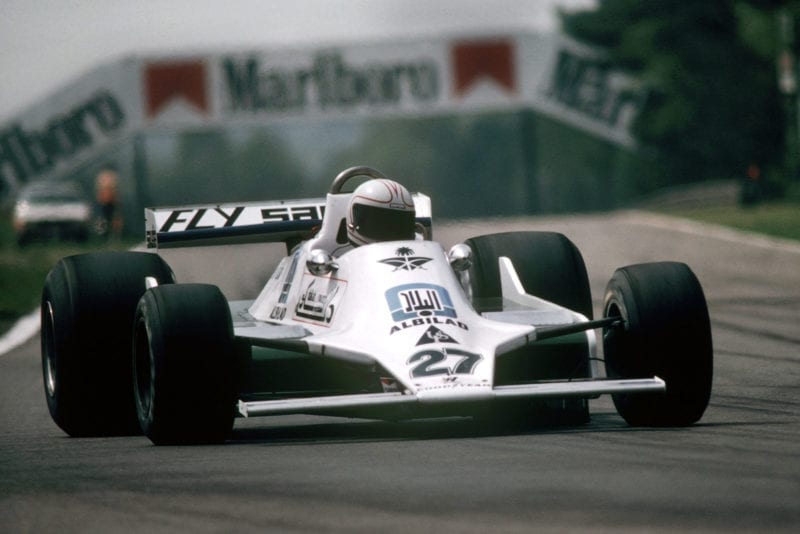
Alan Jones put his Williams 4th on the grid
Motorsport Images
With only about one hour gone the drizzle returned in earnest and everyone gave up and covered everything with tarpaulins, all except Hunt who flogged round on his own in WR7. When he stopped Villeneuve went out on “wet” Michelins, and then Pironi joined him, the Ferrari and the Tyrrell having the track to themselves. When they stopped the whole business of practice faded quietly away and everyone hoped Saturday would be dry.
Friday night prayers were answered and Saturday was dry though overcast, but at least some serious testing could take place in the morning preparatory to the now all-important hour-and-a-half in the afternoon, during which time positions on the grid would be decided. The rather tight confines of the Zolder circuit usually make a position near the front of the grid all-important for any hope of victory. During the morning Villleneuve tried the spare Ferrari (038) and found it quite to his liking. while Andretti spent most of the time patiently waiting while Chapman and the Lotus mechanics struggled to re-tighten the rear end of the Lotus 80 where it had come undone deep within the mechanical conglomeration behind the engine: instant accessibility on the Lotus 80 is not its strong point.
By the time the afternoon session was due to begin everyone was wound up tight and rearing to go. Just to keep everyone from getting too keen (or desperate) the scrutineers had a “Go-No-Go” gauge at the pit lane exit, which checked the height and width of the rear aerofoil. Most teams were playing safe, but one or two were right on the maximum height limit, but there were no problems. That everyone was trying hard was evident by the number of spins during the afternoon, most of them harmless, some causing a little damage, but none very serious. Brakes were being used to the maximum, engines always on peak power, and some exciting diving-through at the last moment when a fast runner was on an all-out lap and caught up with a slower car. The tempo was high but the lap times were not showing it due to a freak phenomenon with the track surface that was not responding to the available grip of a “sticky” short-life qualifying tyre; a bit less for the Goodyears than for the Michelins. It is doubtful whether a lesser-driver can really justify hard, soft or super-soft tyres, but the top bunch of drivers who can really benefit were finding their difference in lap time negligible and many were totally confounded by making their best laps on hard rubber. It was the same for everyone, but the result was that the overall average time was not as good as anticipated. The casual observer would never have known.
Team Ensign had got MN08 repaired for Daly, the oil tank having split the previous day, but now all their efforts faded when the engine blew up. Hunt was back in WR8 and looking quite good, but Watson in the M28B McLaren simply wasn’t in the running, while poor Tambay in the M26 was merely wasting time and effort. Villeneuve was still happy with the spare Ferrari and Scheckter was happy in the brand new one. The two Ligiers were doing it again, the drivers matching each other’s times and forging ahead of the field, but there was a sharp pointed red nose not far away from them. It was a Brabham-Alfa Romeo V12 and it was driven by Nelson Piquet! The new Williams cars were going well and Alan Jones was well up near the front, while Regazzoni was not far behind, while both Ferraris were in there with the best of them, but not dominating. Strangely the Renaults had got left behind in the mad, desperate rush of the afternoon.
The Ligier team’s smiles faded when Depailler had a huge spin off into the protecting fences and damaged his car badly, so that he had to continue practice in the spare car, which was the original prototype JS11. Unfortunately the Frenchman did this right in front of Alan Jones who had to take violent avoiding action, putting his Williams over the kerbs which wrecked the “skirts” on the left hand side. He returned to the pits, where both “skirts” were hitched up and fixed and he carried on without the theoretical maximum advantage of “ground effect.” In this condition he made his best lap of the afternoon at 1 min. 21.59 sec., against Laffite’s best of 1 min. 21.13 sec., and felt confident that with everything working properly on FW07/001 he could have snatched pole-position.
Well before practice was finished Lauda gave up with the newest Brabham, feeling that the engine was down on power, and he transferred to the spare car, BT48/02. However, he didn’t do many laps as he didn’t like the handling of it. Meanwhile his young team-mate was really in the groove and firmly on the second row of the grid, with every possibility of getting on the front row when a water leak sent the temperature gauge soaring up and that was that. In a mad rush he was fitted into Lauda’s number one car, the brand new BT48/04, and sent off again, but time was running out and it was all to no avail. With practice nearly over there was suddenly a great commotion at the first corner, when Andretti and Mass collided and both cars went off the track. When the furore of the afternoon subsided and the Lotus 80, the Arrows and the Ligier were brought in by the breakdown trucks, the furious pace of the afternoon was indicated, yet nobody was near the times of last year due to the track-surface/tyre phenomenon,
The Lotus 80 had suffered damage to the left-front corner, the front pick-up point for the lower wishbone being torn out of the monocoque and the outer end of the top rocker-arm being torn apart. The Arrows suffered a severe bending of the right-rear suspension and the Ligier had suffered a damaged monocoque. There was plenty of work going on in the paddock late on Saturday night. The corner of the Lotus was cut away and some skilled work with tin-snips, pop-rivet gun and welding torch saw a repair effected, while the Arrows mechanics rebuilt the rear end of their car for Jochen Mass. The Ligier team decided that Depailler would use the spare car for the race, and set-to to give it the full race preparation.
When the starting grid was sorted out from the practice times it was seen that everyone had made their best time in the Saturday session, which was not surprising, but the positions of certain drivers in the 24-car line-up were surprising. The two Ligiers occupied the front row, with Laffite on pole position, which we have become used to, but close behind them were Piquet and Jones, in Brabham and Williams, respectively; then came Andretti (Lotus 80) and Villeneuve (Ferrari), with Scheckter (Ferrari) and Regazzoni (Williams) behind them. The two Williams car being so well placed was an encouraging sight for the “Frank Fans”, of which there are a great number. Hunt (Wolf) and Reutemann (Lotus 79) were next, the Englishman showing a bit of his old enthusiasm, and the Argentinian beginning to feel the lack of a Lotus 80. In eleventh and twelth places were the Tyrrell-twins, Jarier and Pironi, while the remaining twelve runners were hardly likely to figure high in the results. Lauda was looking as if he was “doing a James Hunt” and giving up, while the two Renault drivers had been plagued with loss of boost-pressure from their turbo-chargers. Alfa Romeo were well satisfied with Giacomelli’s performance for a first time out, and Rebaque was well pleased with himself. Watson was down amongst some strange company and poor Tambay headed the non-qualifying group, made up of Merzario, Daly and Brancatelli.
Race
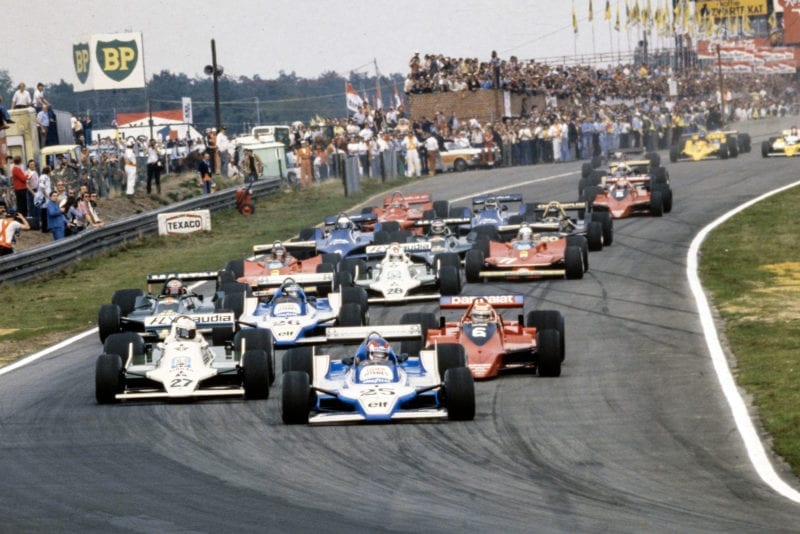
Patrick Depailler’s Ligier leads the pack into the first corner
Motorsport Images
On Sunday morning things looked good, the weather was fine and dry and it was getting nice and warm. In the morning warm-up half-hour Andretti tried the repaired Lotus 80 and also his Lotus 79/5 and after some deliberation decided to race the Lotus 79. Depailler was settled to race the spare Ligier and Villeneuve returned to his original Ferrari, number 039. There was nothing to choose between the two cars and there had been less wear and tear on the later one. Everyone else was in their designated car and Tambay was standing by hopefully, as, first reserve, but it was in vain. An estimated crowd of 75,000 packed the banks and the sandy wooded enclosures and watched the drivers taken round on a parade lap in open-top saloon cars. When they climbed into their racing cars and left the pit lane to drive round to the starting area, all 24 were ready for the 70-lap race. One odd thing was that the Brabham team had their two cars on different types of Goodyear tyres, those on Piquet’s car being much against the wishes of the Goodyear technicians who were convinced they would not last the distance. The stop-go characteristics of the Zolder circuit were making brake temperatures run hotter than was comfortable and many teams had added extra lengths of flexible ducting to try and get more cooling air to the discs. When the starting time of 3 p.m. approached the 24 cars set off on their warm-up lap, led by Laffite, and arriving back at the start drew up in their grid positions. The red light came on, changed to green and the race was on, Depailler getting the jump on his team-mate with Jones hard on the tail of the leading Ligier. Laffite hung momentarily and Piquet was by into third place before the first corner. At the end of lap 1 it was Depailler, Jones, Piquet, Laffite, Andretti, Regazzoni, Scheckter, Villeneuve, Reutemann and Hunt. Into the chicane on the back straight on lap 2 Scheckter and Regazzoni collided, the Ferrari continuing but the Williams being left with a flat left-front tyre and being hit in a rear wheel by Villeneuve’s Ferrari which was close behind. This took the front aerofoil off the Ferrari and broke a wheel, and by the time the French-Canadian had limped round to the pits and had a new nose-piece and aerofoil fitted and a new wheel, he rejoined the race in last place, almost a lap behind the leader. There then began the heroic drive of the day as he lapped faster than the leaders and started to work his way up through the field.
Depailler continued to lead, with Alan Jones hard on his tail and Laffite got by Piquet: the young Brazilian was running his own pace and not trying anything stupid with his more experienced adversaries, but the tyres were not working out at all well. Scheckter was driving hard from the word go and passed Andretti on lap 4 and on the next lap he barged his way by Piquet in a most unruly fashion, giving the Brabham-Alfa Romeo an almighty thump on the left-rear tyre as he did so. Andretti passed the Brabham on lap 7 and on the next lap Piquet stopped at the pits for a more orthodox set of tyres, the delay dropping him down to twenty-second position, one place ahead of Villeneuve. Jabouille stopped at the pits to report low turbo-charger pressure and on lap 11 Reutemann was in the pits unexpectedly with the left-front tyre coming up in bubbles. With a new tyre on he rejoined the race in next to last place and we now had three hard racers making up for time lost through misfortune. Piquet had already passed Lammers and Arnoux, while Reutemann and Villeneuve were not yet in sight of the tail of the field.
During lap 12 Alan Jones had a tentative go at passing Depailler, but it came to nought, and starting lap 13 he made another attempt under braking for the left-hand corner after the pits. Depailler sat it out with him and the Williams was forced to run wide and while the Australian sorted himself out Laffite nipped by into second place. Undeterred Jones continued to press the two blue and white cars with his green and white Williams FW07 and it was a spirited trio out in front. In fourth place Scheckter had them in sight, while Andretti was a lonely fifth, but behind him Hunt had his Wolf sandwiched between the Tyrrell twins and was giving them a bad time. There was a fair gap before a dispirited Lauda appeared, unable to shake off the attentions of Stuck with the ATS. Either Lauda and the Brabham were going awfully badly, or Stuck and the ATS were going extremely well, the truth lying somewhere between the two. Then came the two Arrows, with Patrese leading Mass, the Alfa Romeo, Watson and Fittipaldi with Piquet lining himself up to overtake his fellow Brazilian. Reutemann and Villeneuve had yet to make contact with the tail-enders while de Angelis had a quick pit stop and rejoined the race more or less in the same place, but a whole lap behind. He was in behind the red Alfa Romeo works car and had not gone many laps before he and Giacomelli fell over each other and ended up in the sand.
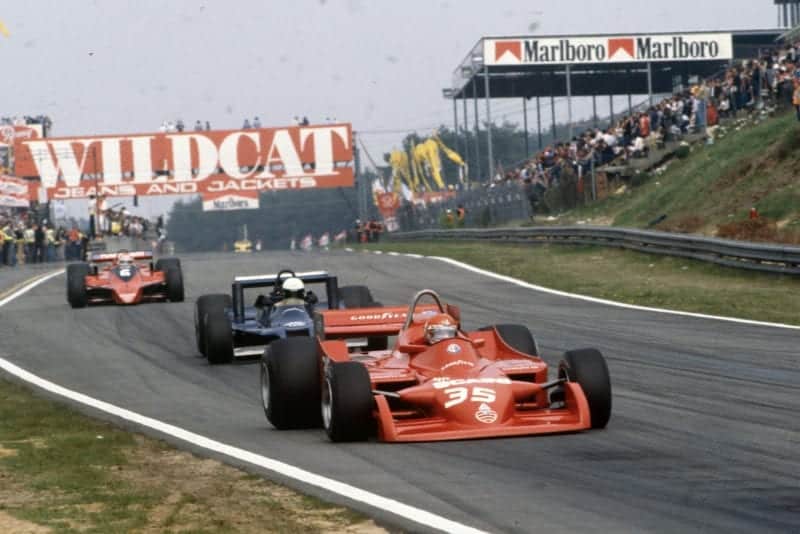
Alfa Romeo’s Bruno Giacomelli crashed out on lap 21
Motorsport Images
At the front of the race the Ligiers were running into an unusual phenomenon that the drivers later blamed on the Goodyear tyres. Without warning the cars would lose adhesion at the front going through some corners and they had to lift right off to regain control. It happened first to Depailler and Laffite went by into the lead, then it happened again and Jones was by into second place. When the phenomenon overtook Laffite the Williams was by into the lead, looking very secure with Alan Jones in full control, his Goodyear tyres giving no problems at all. Scheckter was still in fourth place on his Michelins and the rest of the Goodyear runners were following comfortably, so it rather looked as though it was the Ligier chassis and suspension rather than the tyres that were causing problems. On lap 22 Lauda’s Brabham began pouring out oil and smoke and he kept going for another lap, lubricating the track liberally. A lap later and Piquet came to rest on the back of the circuit with engine trouble so Alfa Romeo’s fortunes sank to zero. Andretti was having a bad time with fading brakes, the pedal going further and further down before anything happened. It finally got to the point where his right foot was pushing the brake pedal so far down that it was taking the accelerator as well and after a couple of exciting moments arriving at corners with the brakes on and the throttle open, with the throttles winning the battle, he gave up.
The Williams and the two Ligiers were neatly spaced out and it didn’t look as though the French were going to be able to do anything about the British. It looked as though Frank Williams’ long overdue victory for his Saudi Arabian sponsors was at last going to happen as half distance approached and Jones looked to be in complete control of the situation. The French cars were dropping back and Scheckter was beginning to sit up and take notice. Villeneuve was consistently lapping faster than anyone and now moving up places steadily, disposing of Lammers, Arnoux and Fittipaldi without easing his pace, and even overtaking Reutemann who was driving a hard and consistent race after his tyre trouble. Hunt got the better of Pironi and pulled away from the two Tyrrells, though the Wolf was swooping about a bit under heavy braking. Even so he was driving hard and closing on Scheckter’s Ferrari very visibly. With retirements., Stuck had moved the ATS up into a good ninth place, ahead of Patrese’s Arrows and Watson’s McLaren, but the German’s good drive was spoilt by a pit stop on lap 35 when a rear wheel gave trouble and had to be changed, this dropping him to next to last, behind Fittipaldi, but he did not give up. Jochen Mass had long since gone when he spun on the slippery surface, ending up on the grass verge with a stalled engine, unable to restart. By lap 40 all seemed settled when without warning the green and white Williams failed to appear. A groan went up from all the Williams supporters when the loudspeakers announced that Jones had stopped. An obscure electrical failure had cut-out the injection pump and the ignition and the engine just stopped. It was really sickening. This put Depailler back into the lead, with Laffite second, Scheckter third, Hunt fourth and Jarier and Pironi fifth and sixth. Hunt’s joy only lasted half a lap for he spun on the entrance to the back straight and damaged a rear wheel against the barriers. As marshals went to his aid Jarier arrived, took violent avoiding action, and slid across a kerb, destroying the left-hand “skirt” on the Tyrrell. He stopped at the pits but nothing could be done so he had to continue at a slower pace, seeing a certain fourth place disappear. By now Villeneuve was up behind Patrese in the Arrows but the arrogant young Italian wouldn’t let the Ferrari by and indulged in some silly blocking tactics. It took Villeneuve nearly ten laps to deal with the stupid young Italian, being very careful not to tangle with him. Once by, the Ferrari just disappeared into the distance from the Arrows, and Patrese then had Reutemann in his mirrors, but even idiots don’t try it on with the swarthy Argentinian.
While this was happening there was drama at the front when Depailler got caught out by the Ligier’s sudden understeer trick and he went straight on into the barriers round the first corner after the pits. This smashed the right-front suspension and left Laffite back in the lead, but by now Scheckter was trying all he knew and closing on the French car. What had been a possible second place for the South African now took on the possibility of victory so he doubled his efforts, and by 50 laps was closing fast. There was nothing Laffite could do as the Ferrari loomed larger in his mirrors and on lap 54 Scheckter was by into the lead, to the accompaniment of loud cheers and flag waving from the Ferrari fans. Villeneuve was now in a remarkable fourth place, from a desperate last, and Reutemann was fifth, these two men being shining examples of real racing drivers. Villeneuve was still pressing on hard and caught and passed Pironi, to move up into third place and on lap 63 he made his fastest lap, which was the ultimate lap record.
Barring accidents the last four laps were obviously going to be routine for everyone was neatly spaced out, the order being Scheckter (Ferrari), Laffite (Ligier), Villeneuve (Ferrari), Pironi (Tyrrell), Reutemann (Lotus), Patrese (Arrows) and Watson (McLaren). The unfortunate Stuck was a lap behind, but had got ahead of Fittipaldi and Lammers (Shadow) and Jarier (Tyrrell) were bringing up the rear. Scheckter took the chequered flag after a hard and determined drive, Laffite followed but Villeneuve failed to appear. The Ferrari ran out of petrol within the last half a lap, so from a secure third place little Gilles Villeneuve had to watch the others go by and relegate him to seventh place, officially one lap behind the winner, but in actual fact part of the way round lap 70.
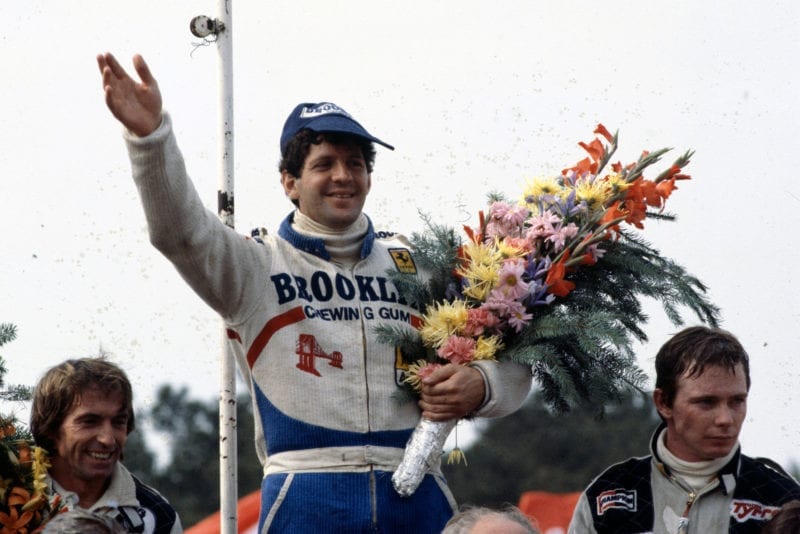
Scheckter celebrates his win
Motorsport Images
It had been a race of bitter disappointment for a lot of drivers and a lot of teams, notably Jones and the Williams team. Depailler and Ligier, Team Lotus. and Brabham. The Ferrari team hardly knew whether to laugh or cry; another gallon of petrol would have made them totally happy, but obviously a Ferrari flat. 12 engine had not been driven as hard for so long, as Villeneuve did following his second lap pit stop, so it was hardly surprising that the fuel consumption was more than they’d known before. The 75,000 spectators must have gone home well satisfied with the excitement and action of the 1979 Belgian Grand Prix, even if many of them were disappointed with the result. — D.S.J.
